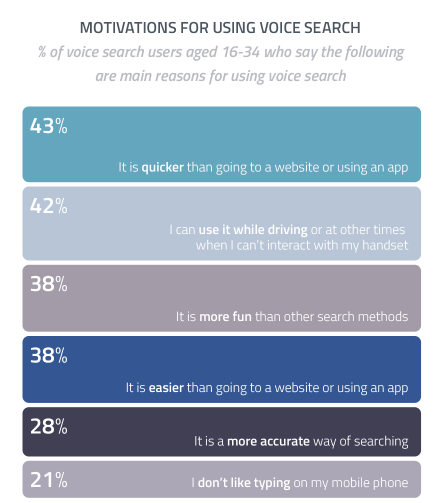When Apple introduced its voice-activated personal assistant to the world in October 2011, "Siri" elicited a range of popular reactions – from wonder and awe to outright skepticism. The new technology seemed amazing, no doubt. But would it prove useful in the long run? Well, after nearly five years we're starting to get a clearer picture, and pardon the pun but voice-activated search sounds like a winner.
Today, an impressive 55% of teens and 41% of adults use voice search on a daily basis (see report).
Whether it's Siri, Google Voice Search, Alexa (Amazon), or voice/sound recognition technology from the likes of Shazam or SoundHound, voice and sound activated virtual assistants are all the talk these days – and brands better start listening. Why? Because now more than ever brands have to reach customers on their terms – and today that's increasingly through voice search via handheld devices.
Sounds reasonable, but what are people actually searching for? And just how are they using voice search?
According to a study by Google, teens and adults are using voice search for many of the same tasks including calling someone, asking for directions, playing a song, finding a restaurant or store, ordering a pizza and getting quick answers to questions. And they’re mostly accessing voice search while performing other activities including driving. Unsurprisingly, teens seem more comfortable with the new technology while adults feel "like geeks" using it. But this awkwardness will no doubt fade once adoption becomes widespread.
So now that you know how voice search is being used and why, one big question remains: How the heck can your brand actually capitalize on it? Glad you asked. Here are 5 suggestions:
5 Ways To Capitalize On Voice Search
1) Help Search Engines Extract Answers From Your Website
Various SEO techniques can be applied to help your brand benefit from voice search including Schema markup. This is simply an add-on to the HTML web coding that provides additional information for the search engines to find such as product reviews, hours of operation, even payment methods accepted. Using Schema markup can also help search engines better understand the context of your content making it easier to translate into voice search results.
2) Make Location-Specific Data Readable
40% of adults (and 38% of teens) use voice search for directions. If your organization has public-facing locations, it's vital that these locations be found via Siri, Google Voice Search and other voice-activated search technologies which beyond your site’s location information, relies on unified citations. A citation is any mention of your address and business name throughout the Internet – think Yelp, Google maps, or even a Chamber of Commerce page. Therefore, it is highly beneficial to make sure there are no conflicts or deviations, however small, between your addresses online.
3) Use Conversational Language, Phrases
Keep your website's content conversational in tone by using natural sentence structures and phrases. Why? As the technology advances, voice search returns will increasingly align with the ways that users speak – and not solely on specific keywords.
4) Focus On FAQs
Users of voice search are mostly looking for the same thing – an answer to a question. This makes FAQs hugely important since their presence can help your site better align with most voice search queries. That said, the use of common question prefixes like the 5 Ws and 1 H (who, what, when, where, why and how) is an absolute must.
5) Provide A Frictionless Experience
Voice-activated search offers brands the opportunity to create amazing experiences. Imagine being able to ask your phone to order you a pizza, for instance. Well, you can (Domino's invested deeply in optimizing their online and digital experience to make sure of this). And if you own an Amazon Echo (a speaker connected to the Alexa Voice Service) you can order Domino's today with a simple voice request.
While it's a bit clunky now, this hands-free service heralds a future in which customers literally don’t have to lift a finger to get the products and services they need.
That said, start thinking of ways to make doing business with your business as friction-less as possible today. Because a truly hands-free tomorrow is almost here.
Conclusion
Voice activated search has quickly moved from novelty to near necessity. For many of us, these A.I. assistants have quietly worked their way into our daily lives, and what now seems miraculous (ordering food by voice alone for example) will one day become routine. That said, even if your brand doesn’t offer something as amazing as pepperoni pizza with extra cheese, it still has the ability to use voice-activated search to make life easier for your customers – and that's something worth talking about.
PS: Want more info on the rise of A.I. assistants? Check out this great article.




